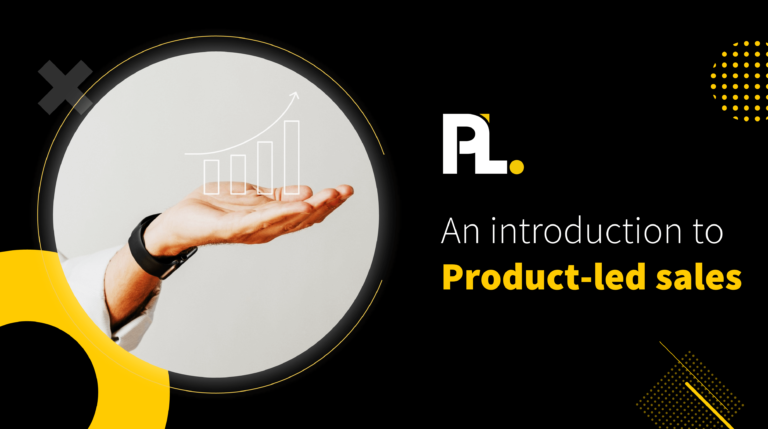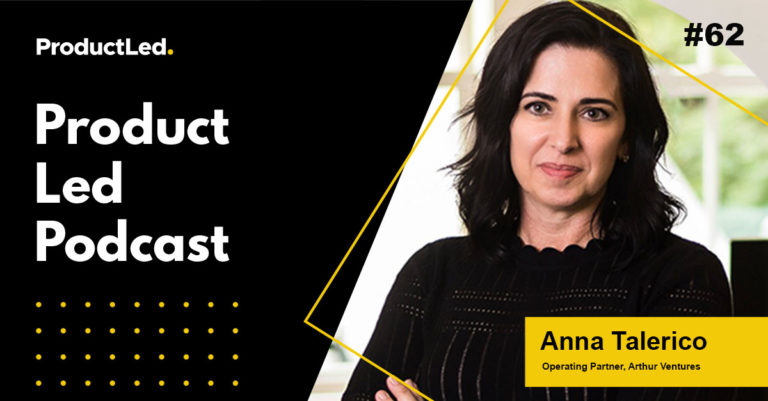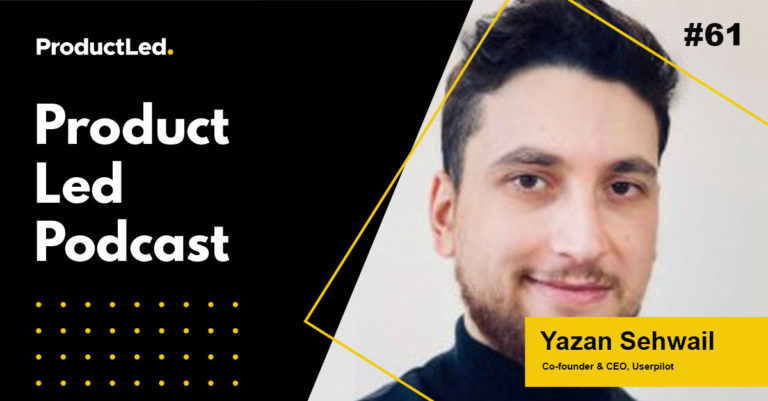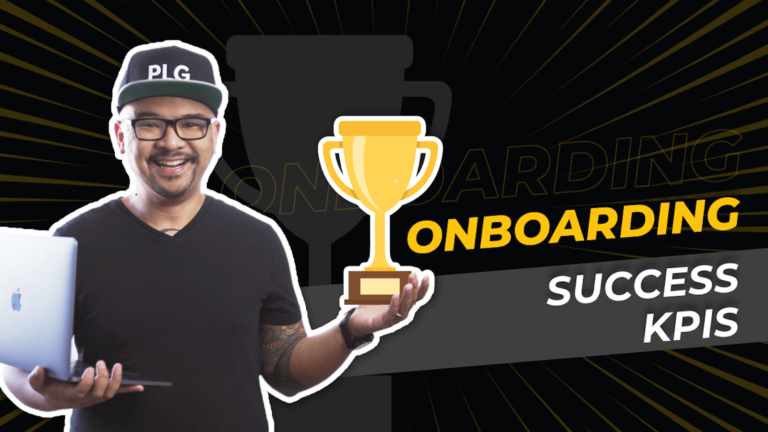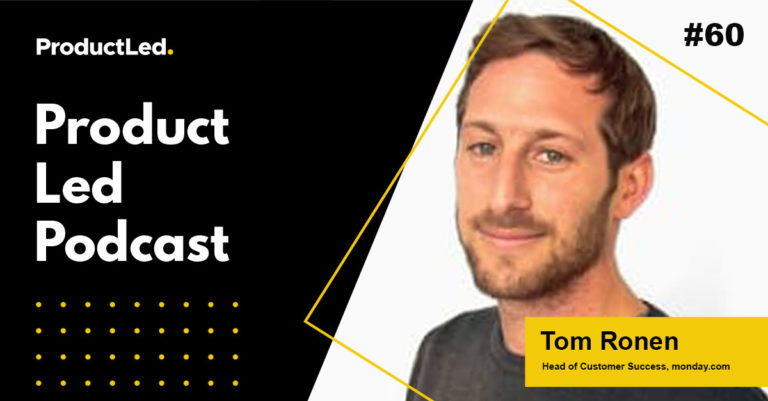With a user base exceeding 45 million worldwide, it's evident that Miro, a visual team collaboration platform, has mastered the go-to-market (GTM) strategy, unlocking the path to a thriving product-led business.
So, what are the key factors behind Miro's product-led growth (PLG) success? Watch the video or read on to find out:
In this post, I will guide you through the main pillars fueling Miro's usage growth, offering useful insights into effective GTM strategies that can enhance your own PLG framework.
What is a GTM Strategy?
A go-to-market strategy is an action plan that outlines how a company will reach its target customers and gain a competitive advantage. It involves understanding market conditions, competitive positioning, ideal customers, and product offerings.
What is a Product-Led GTM Strategy?
The product-led growth GTM strategy focuses on leveraging the product itself as the primary driver of customer acquisition, conversion, and expansion.
A product-led model goes beyond offering a free trial or freemium service. It's about creating a seamless customer journey where the product delivers immediate value and drives users to become paying customers.
Why Miro Believes in PLG
Miro accounts for much of its growth to its product-led growth strategy.
To give you some more perspective on Miro’s growth, here are a few points that reflect just how much growth the company has seen in recent years:
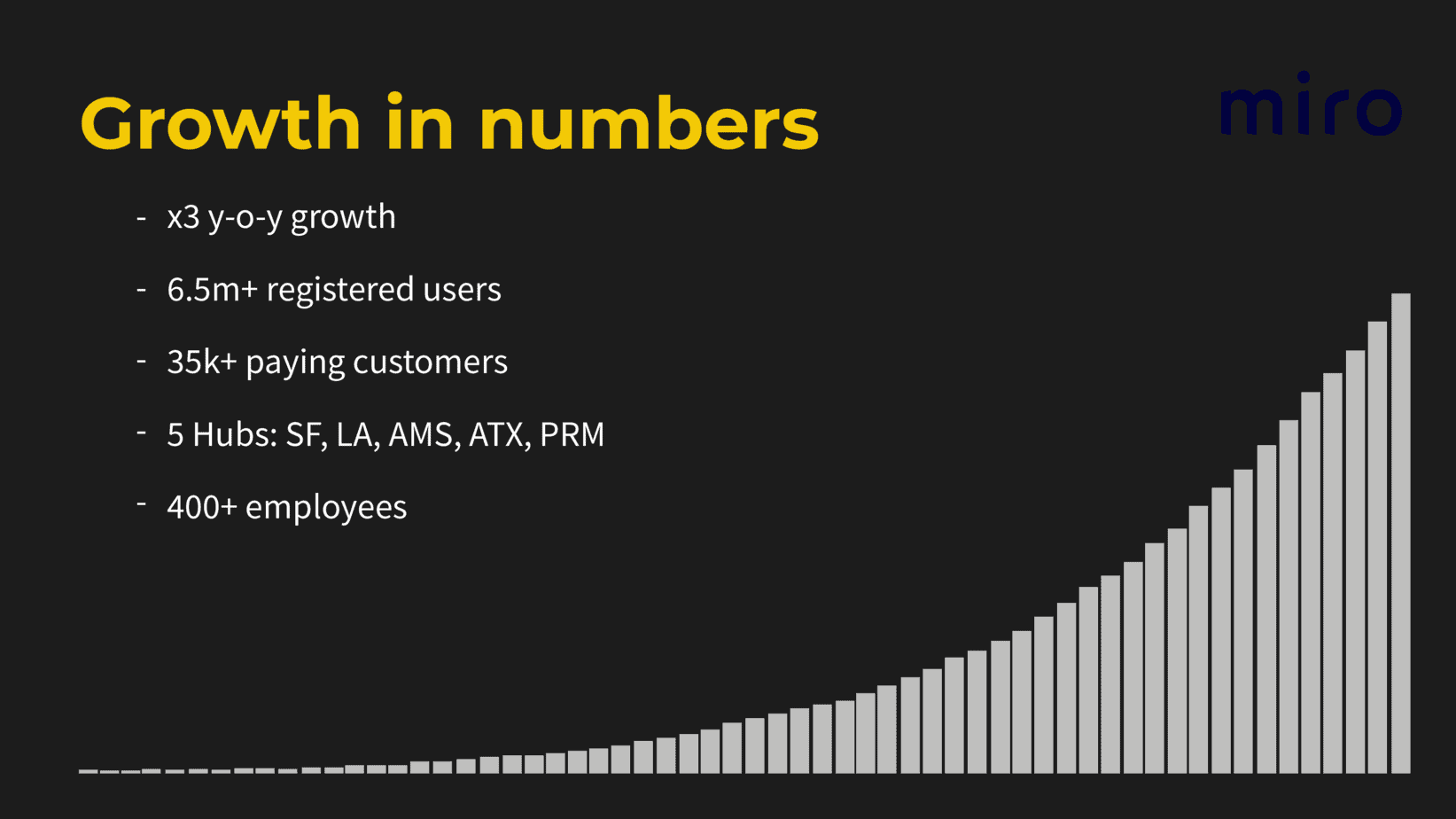
PLG has helped us to onboard and retains users and customers. It drives acquisition, drives our viral loops, and word of mouth whilst building our acquisition competitive muscle. Similarly, product-led growth leads to more monetization. With a higher retention rate and increased engagement, the number of monetization touchpoints that customers come into contact with has also improved.
In the next section, I'll cover the six elements fueling product-led growth at Miro, and these insights can also benefit your own SaaS company.
6 Key Elements of Product-Led GTM Success
Each of these key GTM pillars, outlined below, offers a unique insight into Miro's approach and can offer helpful insights for shaping and refining your own growth strategy.
1. Customer Centricity
We always want to learn from our users. Our users can tell us a lot of important things and we can learn a lot from their usage of the product. We have both a well-defined core audience and main use cases (see image below).
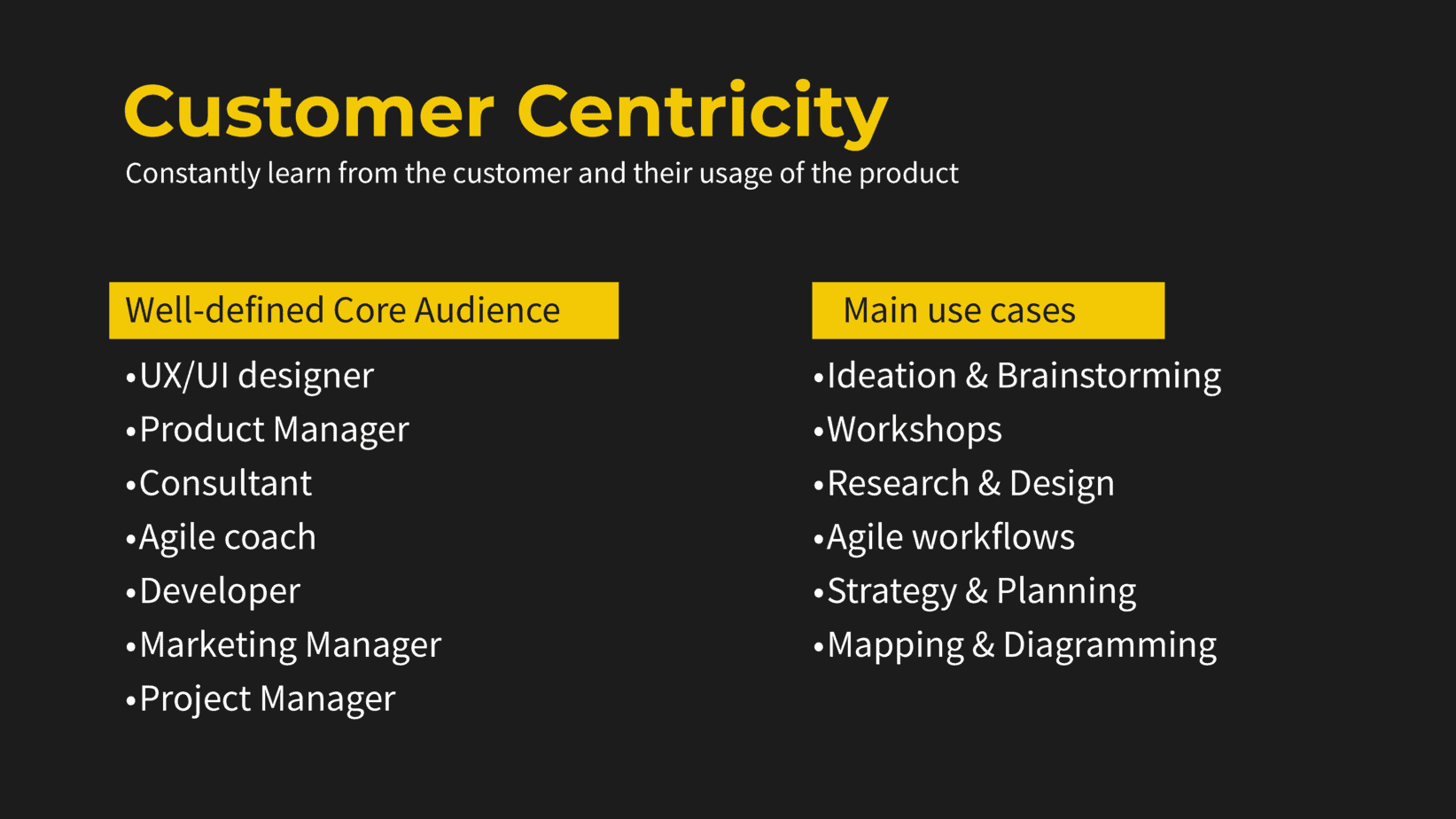
Understanding your audience is crucial for product-led growth. However, don’t make the mistake of assuming that your audience will never change. You must re-evaluate your core audience and main use cases regularly. Different audience members will have different requirements and needs. You must address those directly to help ensure that retention does not decline.
A key part of our customer-centricity plan is to train customer empathy. Having empathy for your audience is a must-have in any industry and business. Your users must believe that you really care about them and their needs.
Miro trains customer empathy in many ways:
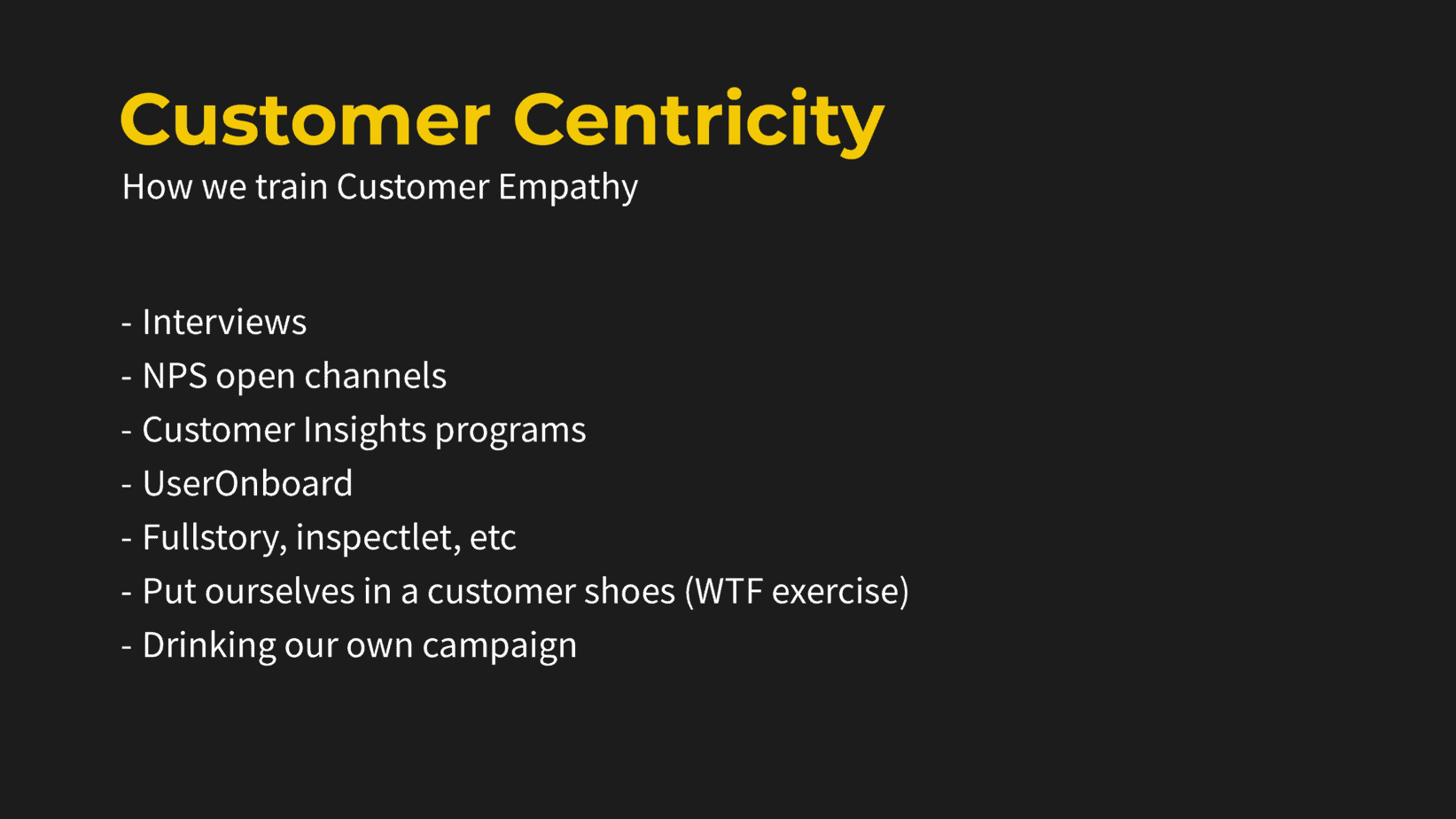
Getting to know your users can really help scale your product-led business. You can identify what made people sign-up to use your product as well as the reasons why somebody decided not to sign-up.
At Miro, we put a lot of effort into putting ourselves in our customers’ shoes. When creating a user map, the team designs and considers every element from the user’s perspective. This is a great way to identify growth opportunities, and room for improvement, and basically go through the steps of using the product from the user’s perspective.
2. Simplicity and Fast Time-to-Value (TTV)
A key to effective PLG is making it as easy as possible for users to get started with the product. You want your product to deliver value as soon as possible. It must be flexible but have a low learning curve. If it is too complicated, users are more likely to give up and look elsewhere.
Miro delivers fast TTV using the freemium model: value first, money later. Users can sign up for the free version of the product, which allows an unlimited number of team members to get started with the product. Users get instant value and become ‘sticky’ before they pay.
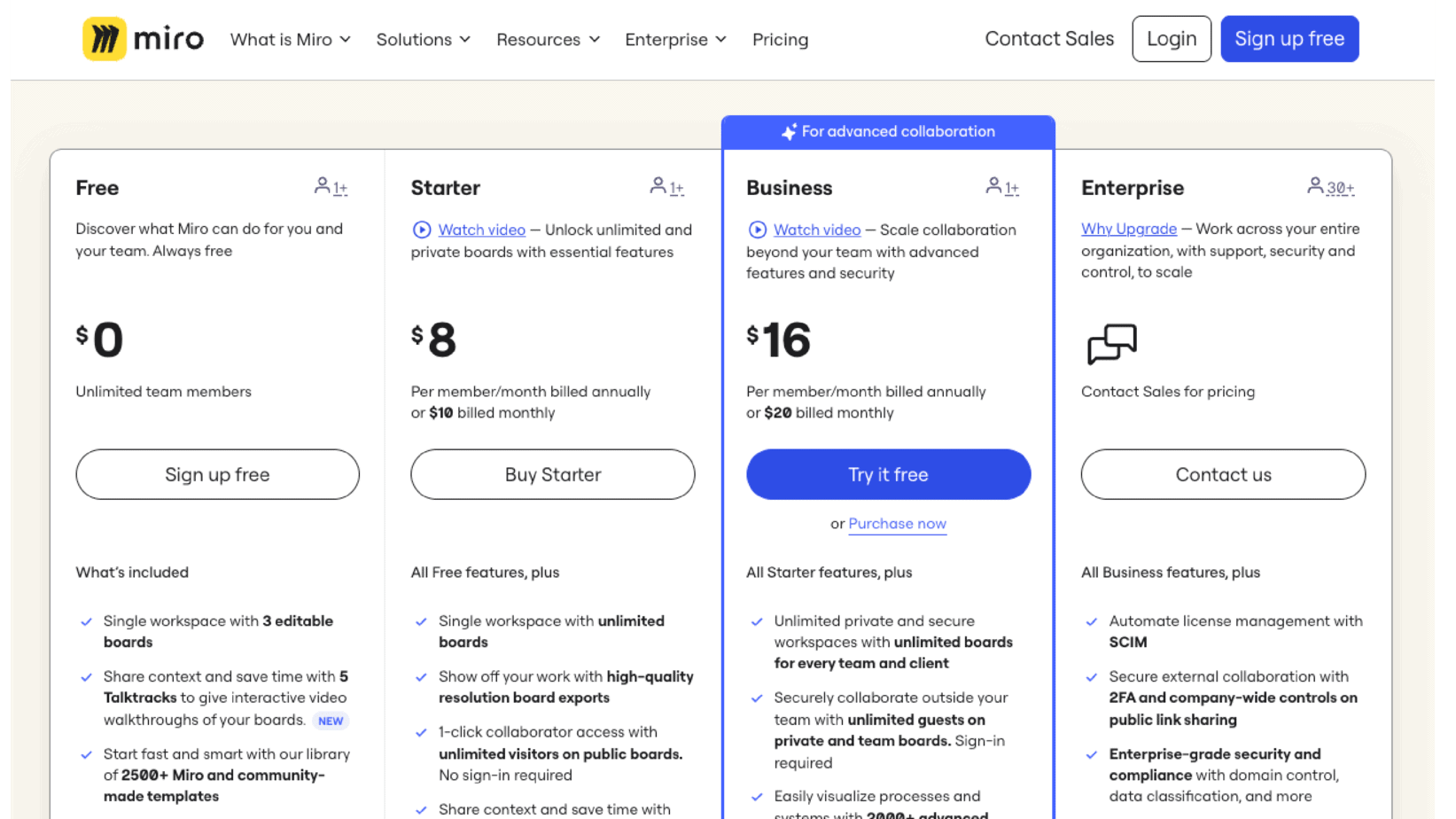
Once users have experienced the product and see the value it delivers, they are more likely to upgrade their membership to one of the paid options. Giving your users free access to your product (or at least a basic version of your product), helps them make an informed buying decision. They have already used the product, they got value from it, and they want even more value and they are willing to pay for that value.
3. Experiment with Customization
Miro uses various templates as an acquisition and activation strategy. It provides users with multiple template choices and makes it easier for them to get started since they’re not starting with a blank canvas.
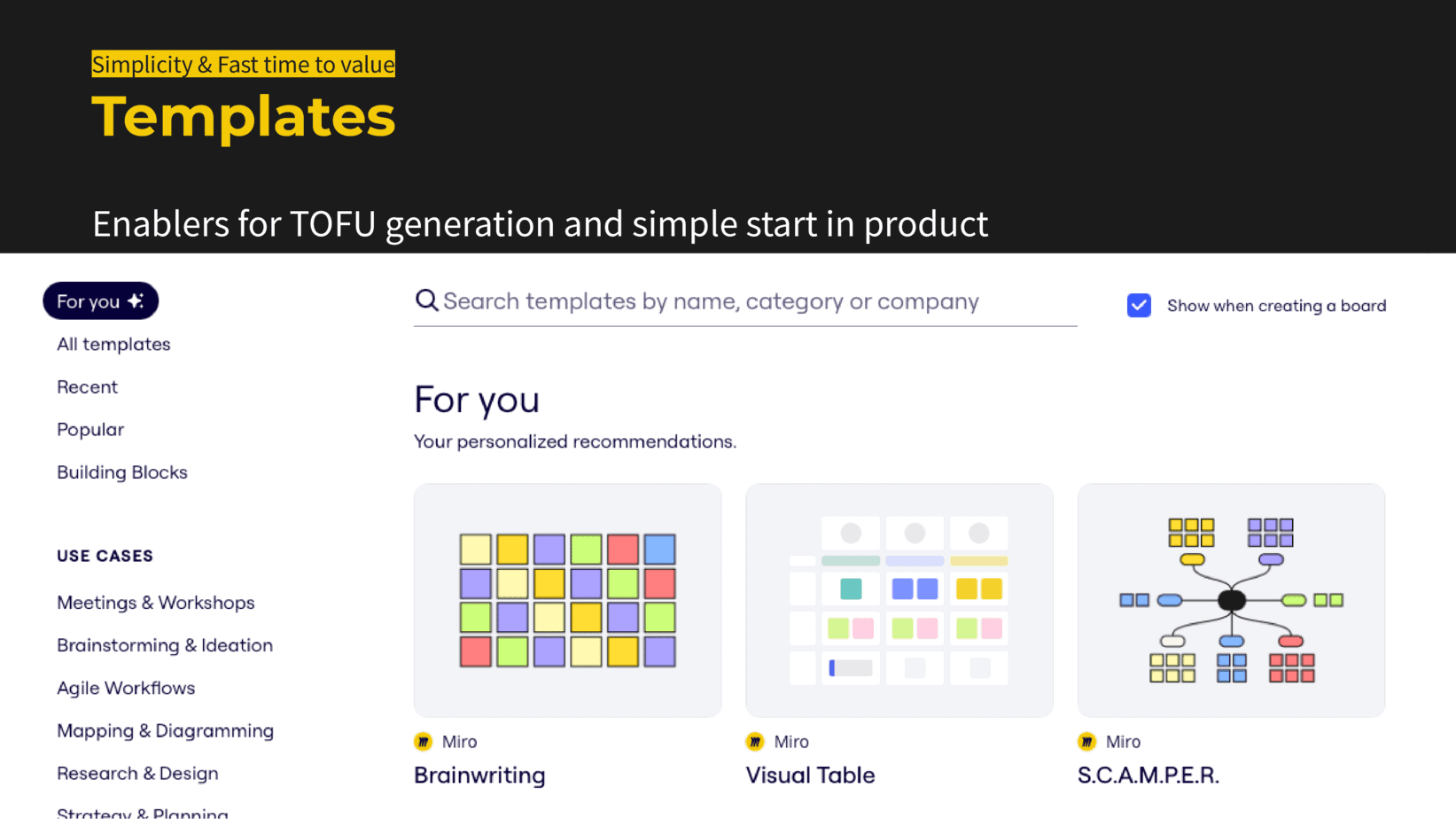
Providing a range of template options also inspires users because it shows them what the product is capable of and what they could possibly use Miro to create.
GTM Strategy Custom Template Example
Miro's go-to-market strategy templates help companies define their target market, identify key customer segments, and understand their unique value proposition. They also helps in creating a roadmap for product positioning, pricing, distribution channels, and marketing campaigns.
For example, let's say a SaaS company is launching a new project management tool. Their go-to-market strategy template would include identifying their target market, such as small to medium-sized businesses in the technology sector. They would then define their unique value proposition, which could be a user-friendly interface and advanced collaboration features.
The template would also guide them in determining the pricing strategy, such as offering tiered pricing plans based on the number of users or projects. It would help them identify the most effective distribution channels, such as partnering with technology resellers or offering direct sales through their website.
4. User Experience (UX)
User experience at Miro is very important, and we strive to create a predictable and pleasant experience for users with diverse backgrounds.
Miro is constantly improving the user experience using prototyping and testing (see below).
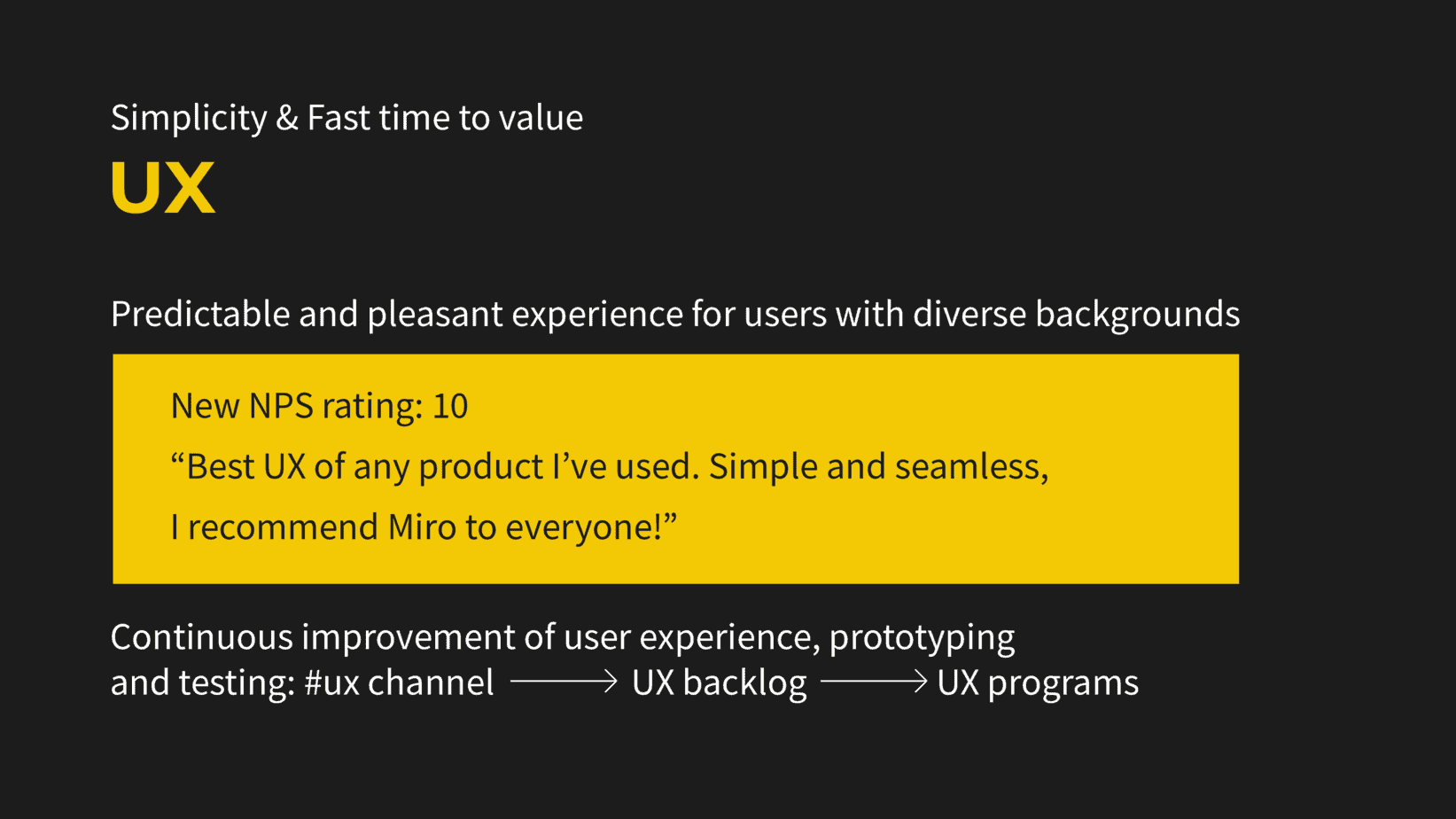
Some users are experienced with the product and do not want to go through any step-by-step guidance protocols. Those users are free to skip ahead and get straight into the product. Users who are new to the product can follow the directions and get the help they need to navigate Miro. This is why Miro does not believe in the one-size fits all approach to UX. Every user is different, and their different needs must be met.
5. Viral Loops to Assist PLG
Viral loops are an essential part of our mission to keep growing as a product-led company. Since Miro is a tool for collaboration, we use viral loops to expand within the organization.
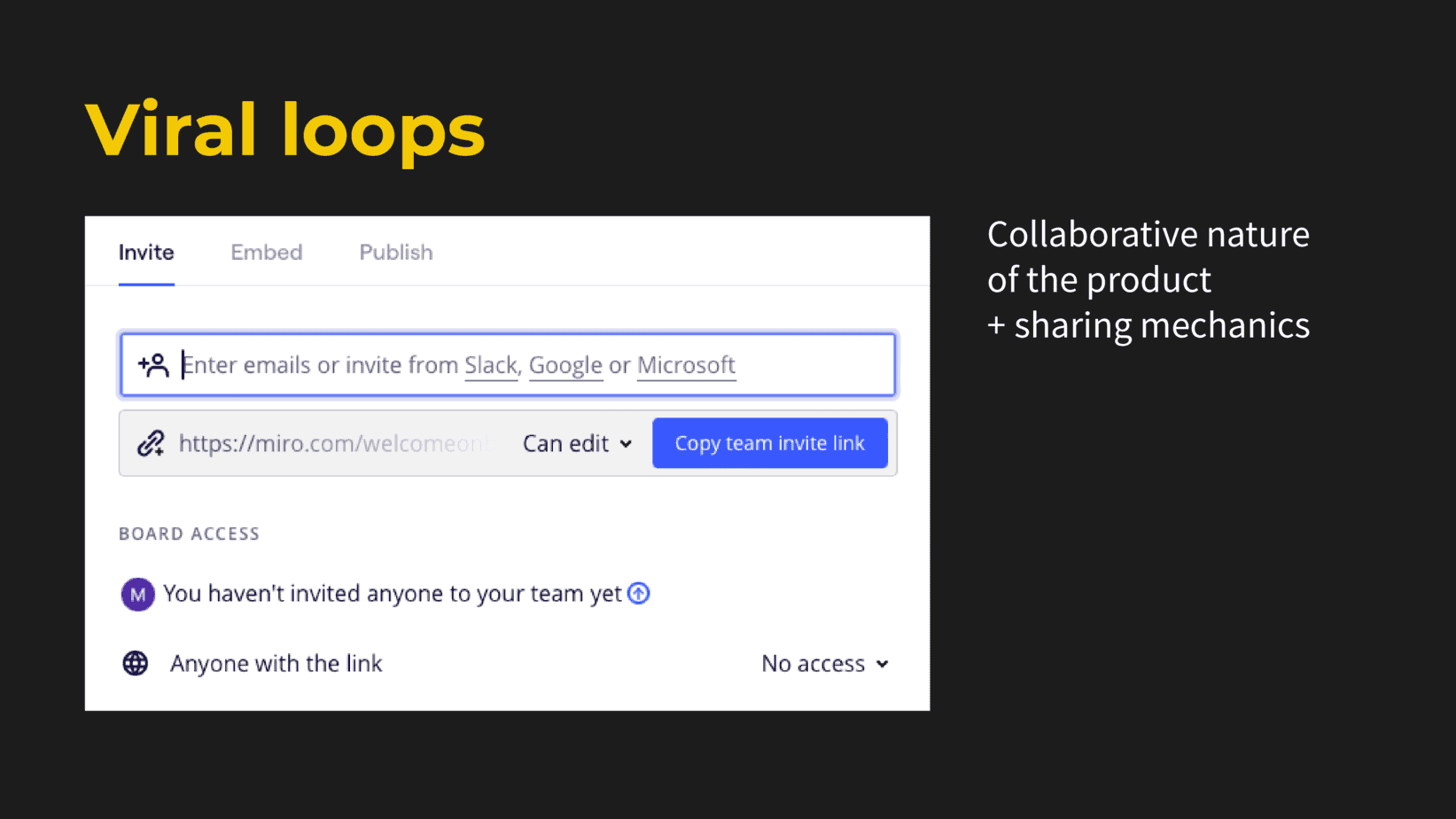
We want to make it easy for users to invite others to join their team and we use viral loops to reduce the friction users may have otherwise experienced doing that. We also use viral loops to allow people to share their boards.
Including sharing mechanics like this has really helped to retain user retention. You can choose who has access to the board, you can invite new members to join your team, and share the board link with whoever you like.
6. User Engagement Strategies
Miro is a horizontal tool, which has been one of our key advantages. However, people can use our product for a variety of cases. Making users aware of this fact means that we have had to combine product design and communications to help make it clear that people can adopt Miro for different purposes. One of the end goals of this is to increase the frequency of usage.
Here is a brief overview of the user engagement strategies adopted by Miro:
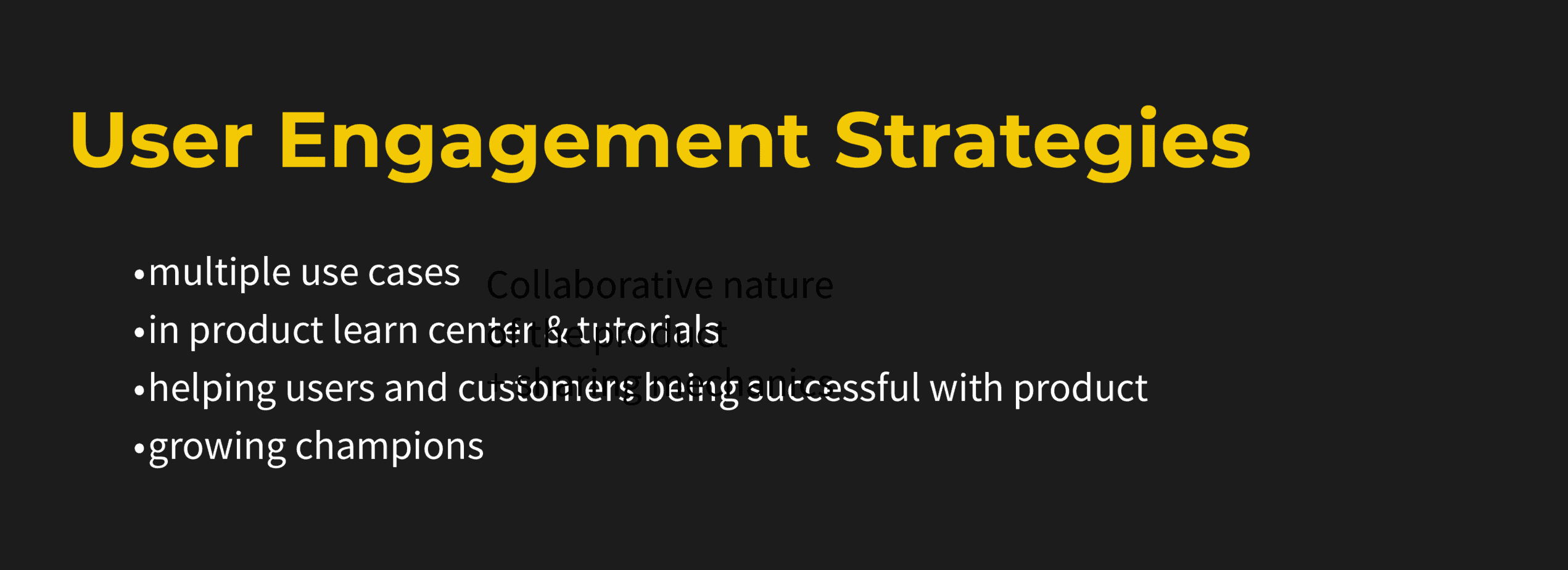
In-product tutorials and the learning center are other elements of our user engagement strategy. This provides users with directional videos to help them use the product more effectively. It also helps the users have more success with the product, and in turn, it helps to create growing champions.
How to Choose the Right GTM Strategy for Your SaaS Business
Choosing the right GTM strategy is a critical decision for SaaS businesses. By understanding the unique characteristics of your product and considering factors such as ease of use and complexity of the sales process, you can select a strategy that will drive customer acquisition and long-term success.
Product-Led Vs Sales-Led Strategy
The first step in selecting a GTM strategy is understanding the two main approaches: product-led and sales-led. A product-led GTM strategy focuses on allowing customers to experience the value of the product quickly, leading to long-term paying customers. On the other hand, a sales-led GTM strategy relies on a sales team to drive customer acquisition and revenue growth.
To make the right choice, it's important to consider the unique characteristics of your SaaS business. A product-led GTM strategy is ideal if your product is intuitive, easy to use, and provides immediate value to customers. It allows users to explore and understand the product on their own terms, leading to higher adoption rates and customer satisfaction.
However, if your product requires a more complex sales process, a sales-led GTM strategy might be a better fit. This approach involves a dedicated sales team that can effectively communicate the value proposition, handle objections, and close deals.
Implementing a GTM strategy requires careful planning and coordination across different teams, including marketing and product development. It's crucial to align these teams to ensure a seamless customer journey and maximize the impact of your chosen strategy.
Your Path to PLG Success
If you have a product-led strategy or shifting away from a sales-led appraoch, you must track product-oriented metrics, including engagement, feature usage, acquisition channels, time to value, conversion funnels, and more.
Surprisingly, product-led growth is not just about the product. Marketing, sales, and pricing all play key roles in determining users engagement and conversion rates.
Above all, PLG is about providing users with a great product experience, and that’s what Miro focuses on with each product-led growth strategy we implement.
If you’d like to work with a coach to develop a GTM strategy that's tailored to your SaaS company, be sure to check out ProductLed Academy
It’s our intensive coaching program where we’ll help you build a strong foundation for product-led growth so that you can scale faster and with more control.
What’s unique about this program is we’ll work with you and your team to implement the proven ProductLed Method so that you can scale faster with less stress.
We’ll go through everything we went through today with your team to make sure that everyone is aligned on who your ideal user is for your team.

